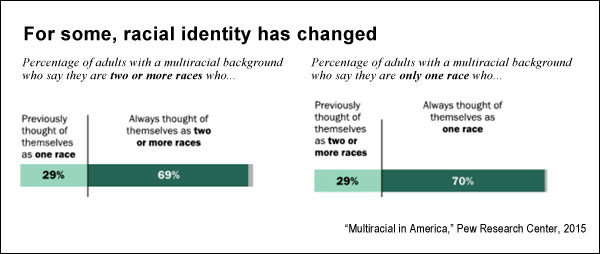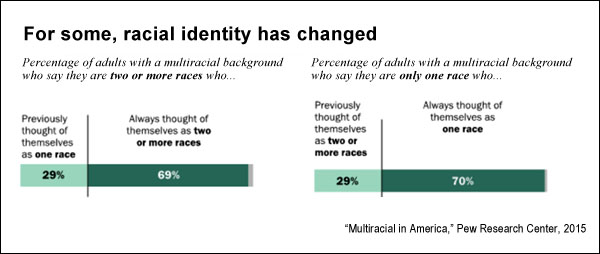
For millions of Americans, issues of racial and ethnic identification are frequently complicated, a legacy of the country’s endless waves of immigration as well as its long history of slavery and expansion into Native American lands across the continent.
“Passing” as white was not uncommon in the pre-Civil Rights era, when strict separation between African-Americans and whites was generally expected in many places. With the rise of “minority majority” America, questions of boundaries and overlapping identities continue to grow only more nuanced and complex. Of course, racial categories are social constructs; scholars note that even perceived “monolithic” identities such as African-American almost always, genetically speaking, encompass mixed races.
A 2015 Pew Research Center survey found that an estimated 6.9% of Americans identify as multiracial, and a sizable percentage of these individuals report having changed the way they previously thought about their racial identity. By far the largest multiracial group is comprised of mixed Native American-Caucasian ancestry.
Beginning in 2000, the U.S. Census Bureau began allowing for individuals to self-identify as more than one race on its survey forms. The 2010 Census recorded some 9 million people of mixed-race status (2.9% of the population overall), and more than 700,000 persons identified with three or four different races. (The more recent Pew survey, then, suggests that the Census numbers may reflect an under-count.)
The June 2015 controversy over the head of the Spokane Washington NAACP chapter, Rachel Dolezal, who resigned after her biological parents revealed in 2015 that her ancestry was predominantly white with some Native American ancestry, is just the latest chapter in a long, tangled history of racial identity in America — encompassing issues that go well beyond black and white. For example, research has found that after the 9/11 attacks there was a substantial decrease in the probability that Arab and Muslim Americans would self-identify as white. Even among sub-groups, such as Cuban-Americans, there are long-running, intra-community debates over ethnicity and race.
Social scientists continue to study the impact of racial issues across diverse areas, from the way economic scarcity can influence perceptions; to issues of law enforcement and criminal justice; to the way race can shape the mechanisms of policy and politics.
Below is a selection of research on race, ethnicity and identity in the United States.
————————-
“Adolescent Racial Identity Self-Identification of Multiple and ‘Other’ Race/Ethnicities”
Harris, Bryn; Ravert, Russell D.; Sullivan, Amanda L. Urban Education, March 2015. doi: 10.1177/0042085915574527.
Abstract: “This mixed-methods study focused on adolescents who rejected conventional singular racial/ethnic categorization by selecting multiple race/ethnicities or writing descriptions of ‘Other’ racial/ethnic identities in response to a survey item asking them to identify their race/ethnicity. Written responses reflected eight distinct categories ranging from elaborative descriptions of conventional race categories to responses refusing the construct of race/ethnicity. Students’ endorsement of multiple or ‘Other’ ethnicities, and the resultant categories, differed by gender, grade, school type, and school compositions. Findings support scholars’ concern that common conceptualizations of race may not capture the complexity of self-identified racial categories among youth.”
“Monoracial and Biracial Children: Effects of Racial Identity Saliency on Social Learning and Social Preferences”
Gaither, Sarah E.; et al. Child Development, July 2014, Vol. 85, Issue 6, 2299-2316. doi: 10.1111/cdev.12266.
Abstract: “Children prefer learning from, and affiliating with, their racial in-group but those preferences may vary for biracial children. Monoracial (white, black, Asian) and biracial (black/white, Asian/white) children (N = 246, 3–8 years) had their racial identity primed. In a learning preferences task, participants determined the function of a novel object after watching adults (white, black and Asian) demonstrate its uses. In the social preferences task, participants saw pairs of children (white, black and Asian) and chose with whom they most wanted to socially affiliate. Biracial children showed flexibility in racial identification during learning and social tasks. However, minority-primed biracial children were not more likely than monoracial minorities to socially affiliate with primed racial in-group members, indicating their in-group preferences are contextually based.”
“The Genetic Ancestry of African Americans, Latinos and European Americans across the United States”
Bryc, Katarzyna; et al. American Journal of Human Genetics, Vol. 96, 37–53, January 2015. doi: 10.1016/j.ajhg.2014.11.010.
Abstract: “Over the past 500 years, North America has been the site of ongoing mixing of Native Americans, European settlers and Africans (brought largely by the trans-Atlantic slave trade), shaping the early history of what became the United States. We studied the genetic ancestry of 5,269 self-described African Americans, 8,663 Latinos, and 148,789 European Americans who are 23andMe customers and show that the legacy of these historical interactions is visible in the genetic ancestry of present-day Americans. We document pervasive mixed ancestry and asymmetrical male and female ancestry contributions in all groups studied. We show that regional ancestry differences reflect historical events, such as early Spanish colonization, waves of immigration from many regions of Europe, and forced relocation of Native Americans within the U.S. This study sheds light on the fine-scale differences in ancestry within and across the United States and informs our understanding of the relationship between racial and ethnic identities and genetic ancestry.”
“Developmental Flexibility in the Age of Globalization: Autonomy and Identity Development Among Immigrant Adolescents”
Fuligni, Andrew; Tsai, Kim M. Annual Review of Psychology, July 2014, Vol. 66, 411-431. doi: 10.1146/annurev-psych-010814-015111.
Abstract: “The socioeconomic and cultural changes that result from an increasingly interconnected world have been speculated to have important implications for the nature of adolescent development. Unfortunately, the historical time necessary for these changes to take place means that definitive research on the impact of globalization necessarily will be slow in forthcoming. Adolescents from immigrant families, however, already experience the social and cultural shifts thought to typify globalization, and an analysis of their experiences could shed light on what to expect as existing national barriers become more permeable. The value of flexibility in the face of great social and cultural change appears to be the dominant theme from research on immigrant youth, although that flexibility can be constrained by socioeconomic, ethnic, and racial stratification systems in host societies. This review highlights the implications of these findings for what may lie ahead for teenagers as globalization continues to expand.”
“Stigmatization and Racial Selection after September 11, 2001: Self-identity Among Arab and Islamic Americans”
Mason, Patrick L.; Matella, Andrew. Journal of Migration, October 2014. doi: 10.1186/s40176-014-0020-9.
Abstract: “During the 2000s, Arab and Islamic American racial identity selection was subjected to an exogenous racializing event, viz., public and private reaction to the Al Qaeda attacks of September 11, 2001. The Al Qaeda attacks clearly demarcate a period in which there was a structural increase in the intensity of U.S. stigmatization of persons with Islamic religious affiliation and Arab ethnicity. This stigmatization created an exogenous reduction in the expected payoff to acculturation relative to non-acculturation. This paper uses self-identification as white as its measure of acculturation and the fraction of all hate crimes directed at Muslims as its measure of stigmatization after 9/11. Comparing 2002–2012 to 1996–2001, there is a statistically significant and substantively large decrease in the unconditional and conditional probabilities that Arab and Islamic Americans will self-identify as white.”
“Racial Identity and Well-Being among African Americans”
Hughes, Michael; et al. Social Psychology Quarterly, January 2015. doi: 10.1177/0190272514554043.
Abstract: “How racial identity influences self-esteem and psychological well-being among African Americans remains unresolved due to unexplained inconsistencies in theoretical predictions and empirical findings. Using data from the National Survey of American Life (N = 3,570), we tested hypotheses derived from social identity theory and the internalized racism perspective. Findings support social identity theory in showing that African Americans strongly identify with their group and view it very positively. In addition, those who identify more with their group and evaluate it more positively have greater self-esteem, greater mastery, and fewer depressive symptoms. However, findings also support the internalized racism perspective by showing that when group evaluation is relatively negative, racial identification is related to lower mastery and higher depressive symptoms.”
“The Protective Role of Ethnic Identity for Urban Adolescent Males Facing Multiple Stressors”
Williams, Joanna L.; et al. Journal of Youth and Adolescence, October 2014, Vol. 43, Issue 10, 1728-1741.
Abstract: ” Having a connection to one’s ethnic heritage is considered a protective factor in the face of discrimination; however, it is unclear whether the protective effects are persistent across multiple stressors. Furthermore, the dimensions of ethnic identity that reflect group pride/connection (affirmation) and exploration of the meaning of group membership (achievement) may operate differently in the face of stress. The present study examined the moderating role of ethnic identity affirmation and achievement on concurrent and longitudinal relationships between exposure to stress (discrimination, family hardship, exposure to violence) and antisocial behavior in a sample of 256 Black and Latino male youth (70% Black) living in low-income urban neighborhoods. Using regression analysis, concurrent associations were examined at age 18, and longitudinal associations were tested 18 months later. We found that, among youth experiencing discrimination, high levels of achievement and low levels of affirmation predicted greater aggressive behavior and delinquency. Low affirmation also predicted more criminal offending in the face of discrimination. The two dimensions operated similarly in the context of family stress, in which case high levels of affirmation and achievement predicted lower levels of antisocial behavior.”
“Redefining Racial Categories: The Dynamics of Identity Among Brazilian-Americans”
Fritz, Catarina. Immigrants & Minorities: Historical Studies in Ethnicity, Migration and Diaspora, June 2014, Vol. 3, Issue 1. doi: 10.1080/02619288.2014.909732.
Abstract: “Research based on a sample of Brazilian youth living in Massachusetts reveals a variety of responses to racialisation of their phenotypes. Caught between the fluid patterns of colour categories found in Brazilian society and the more rigid racial stratification that characterises the USA, Brazilian-Americans have followed a variety of strategies to adapt to this situation. By exploring the reactions of these young adults of different appearance along the colour continuum to the constraints of the dominant society, questions concerning the future dynamics of race relations in the USA are raised against a background of the continuing post-racialism debate.”
Keywords: race, ethnicity, self-identity, African-American, Latino, Hispanic, Native American, Indian, Asian, research roundup

